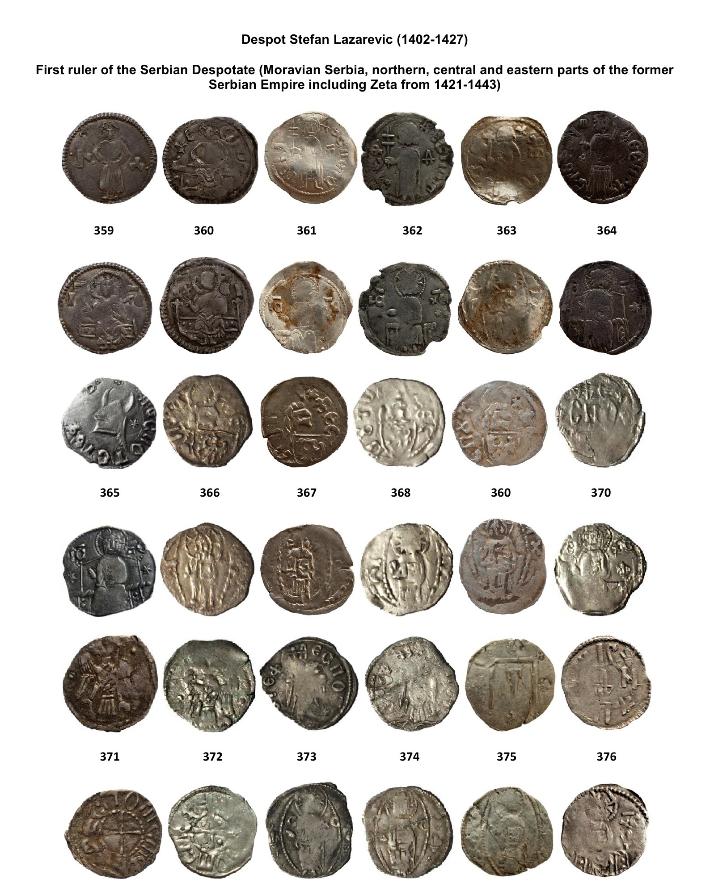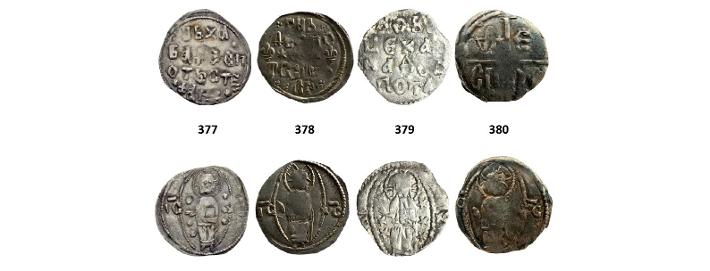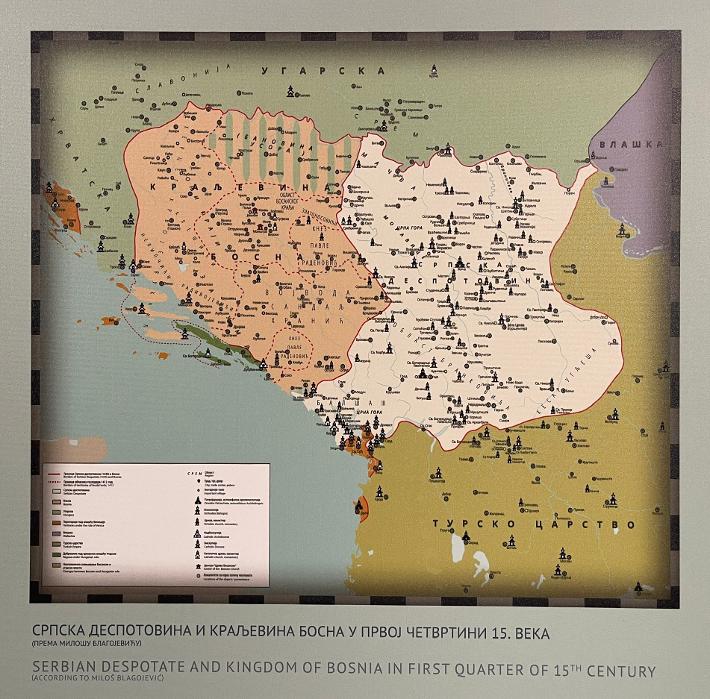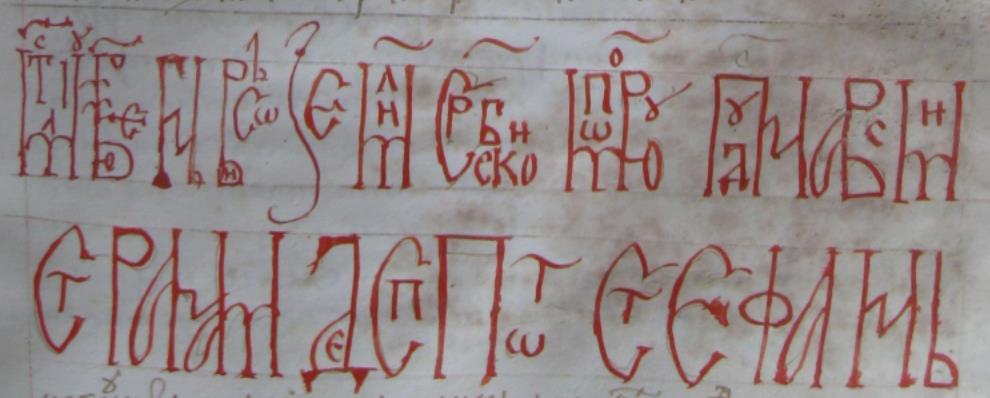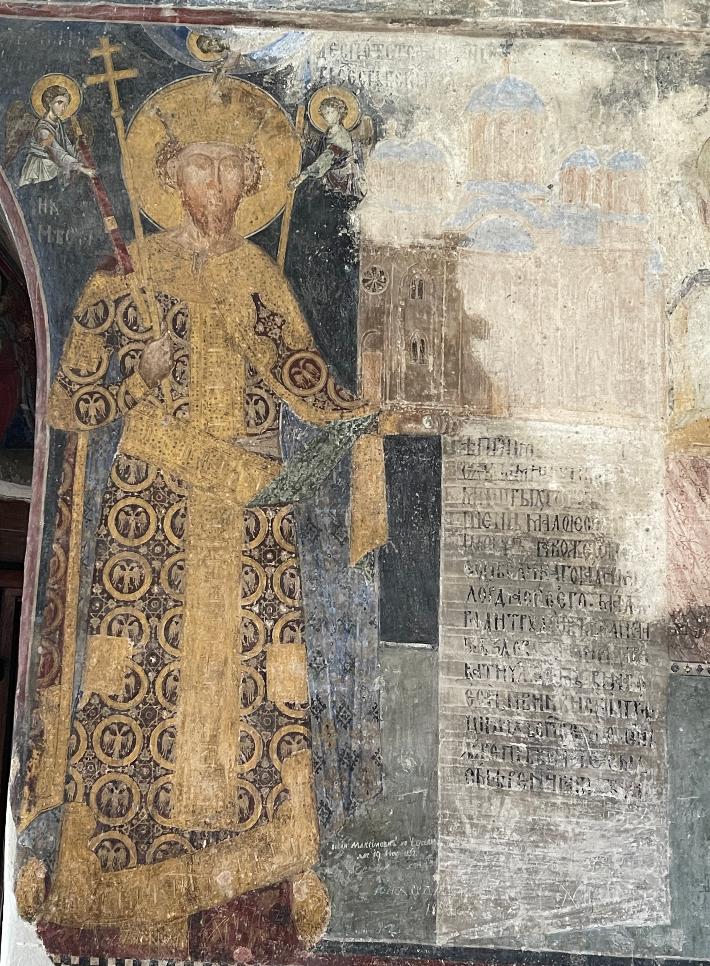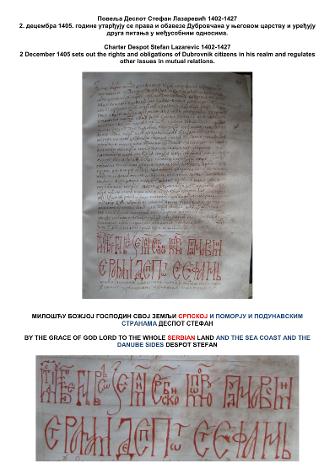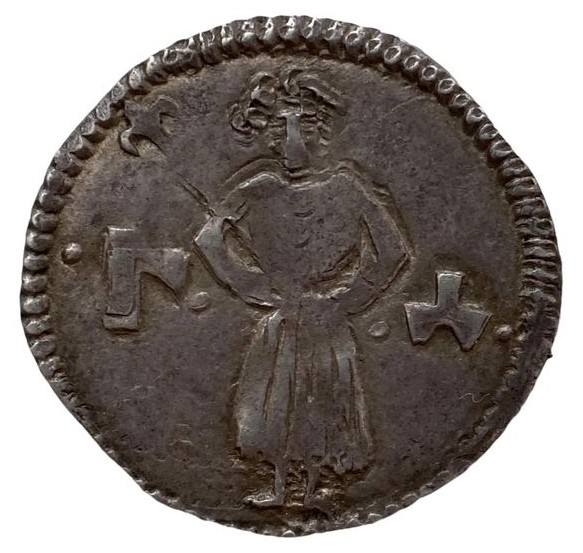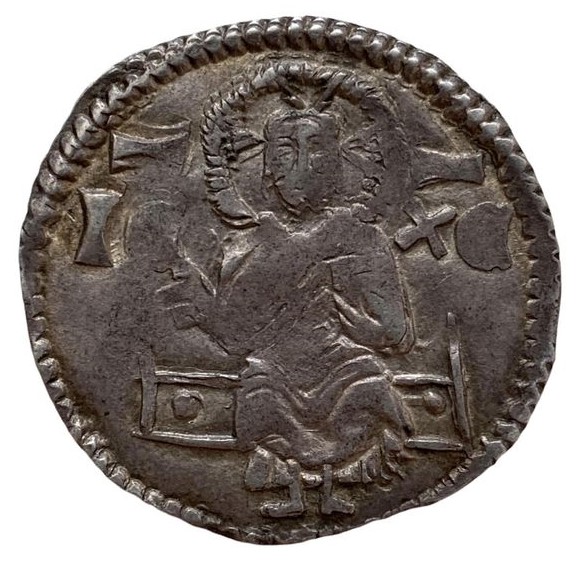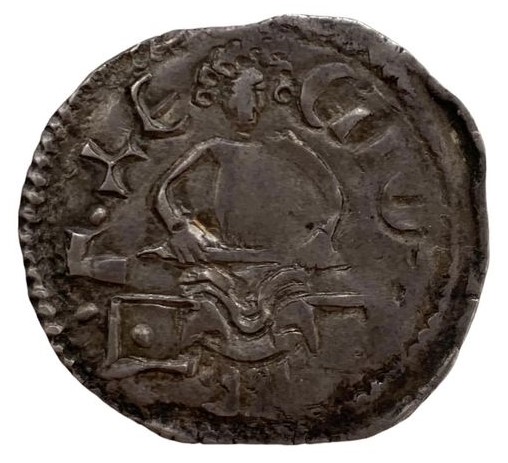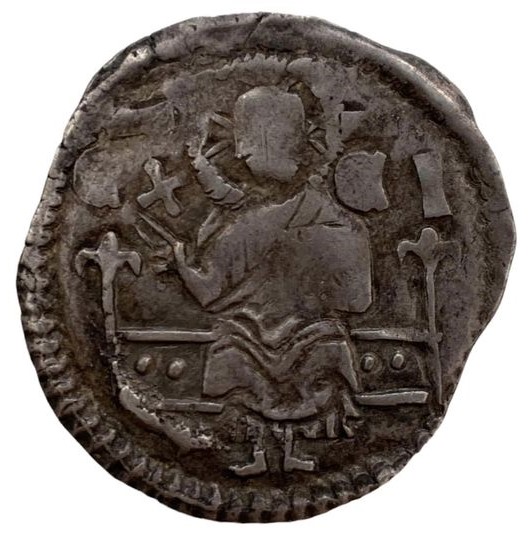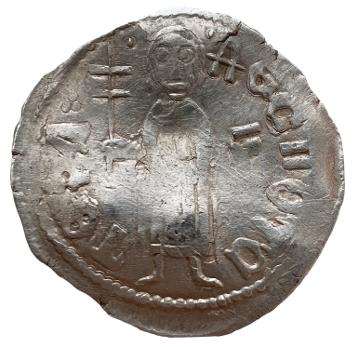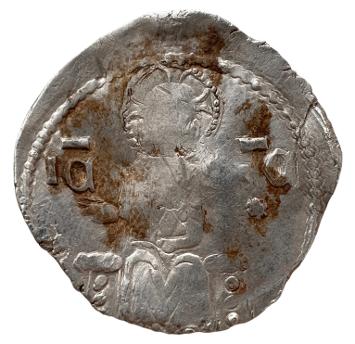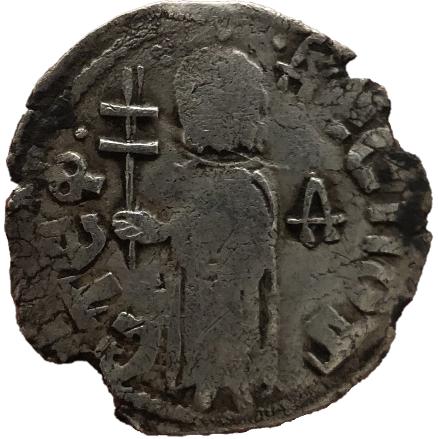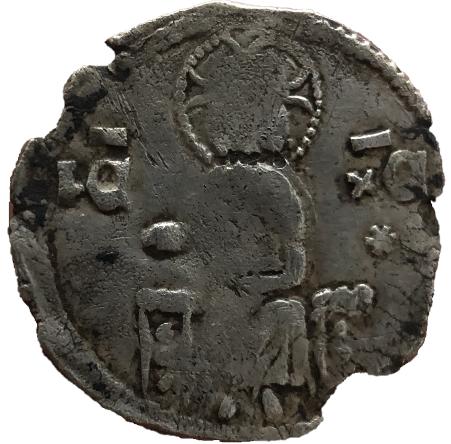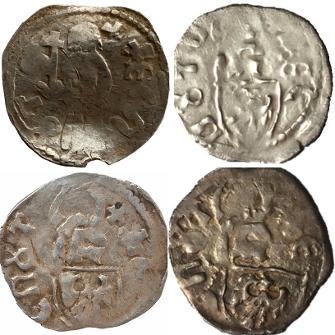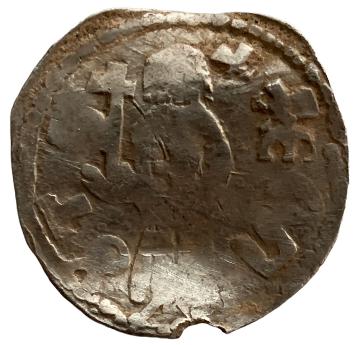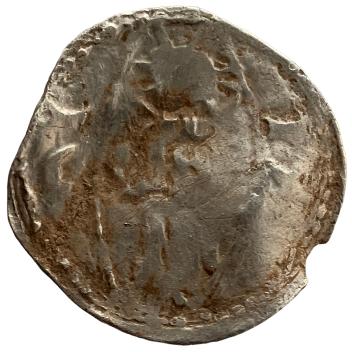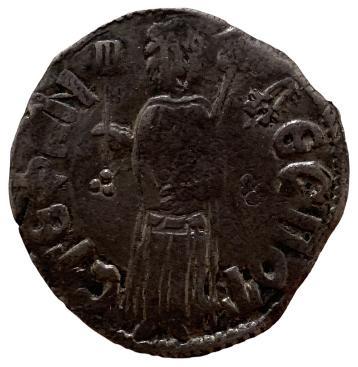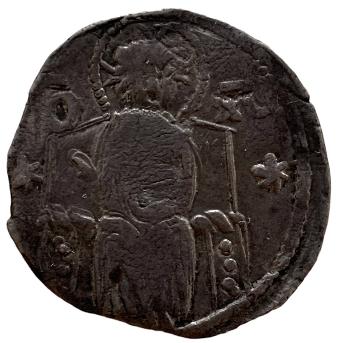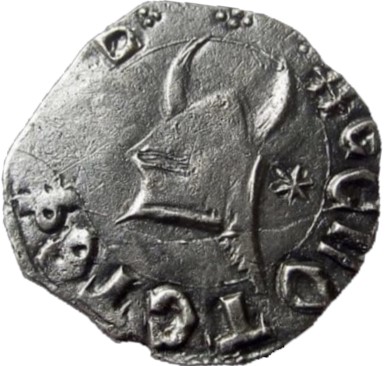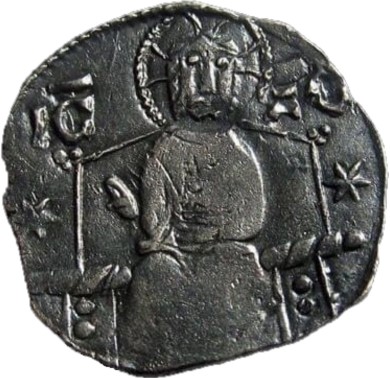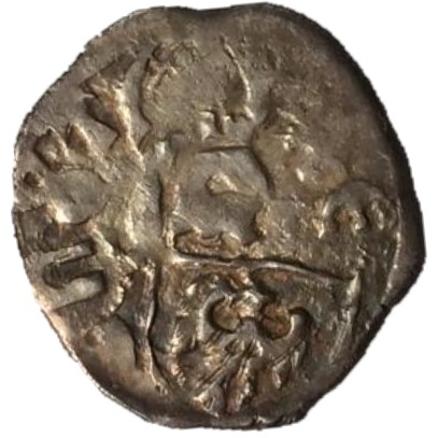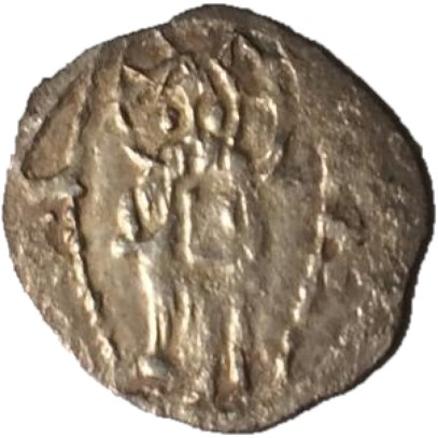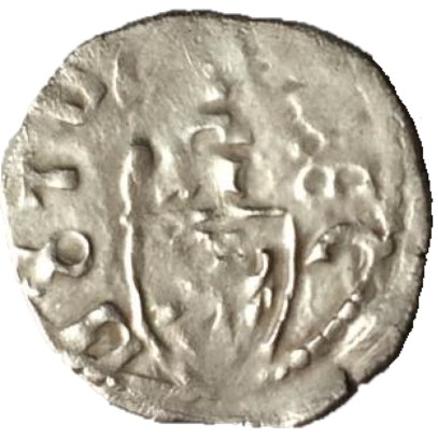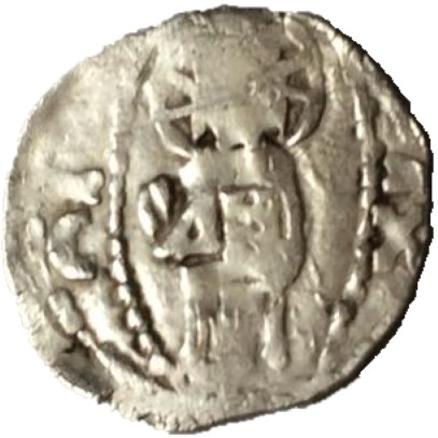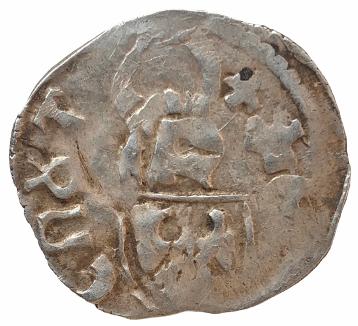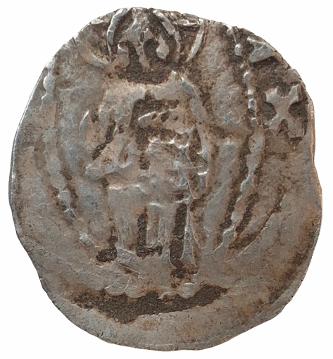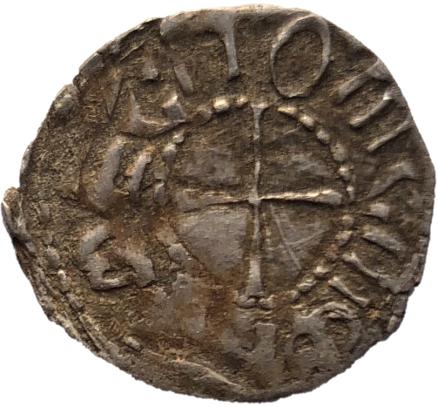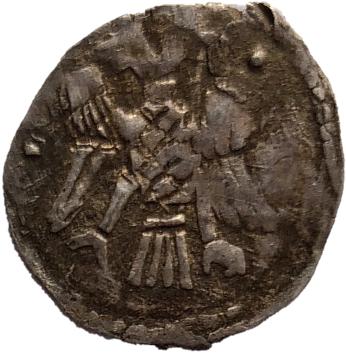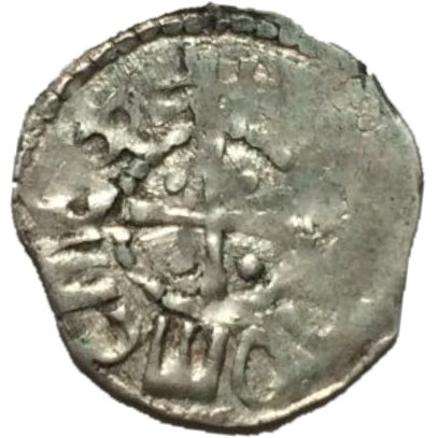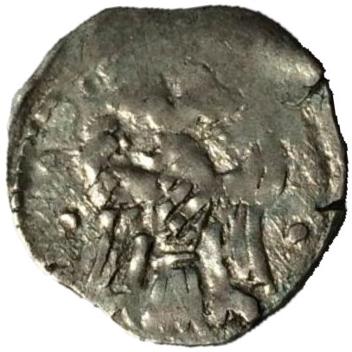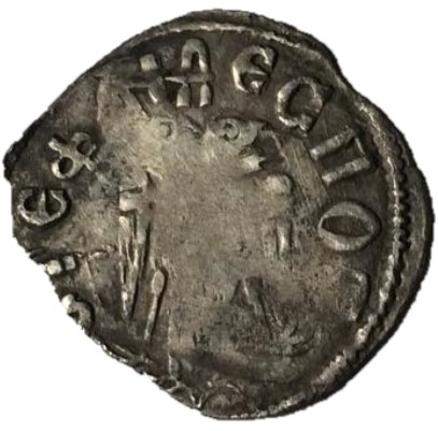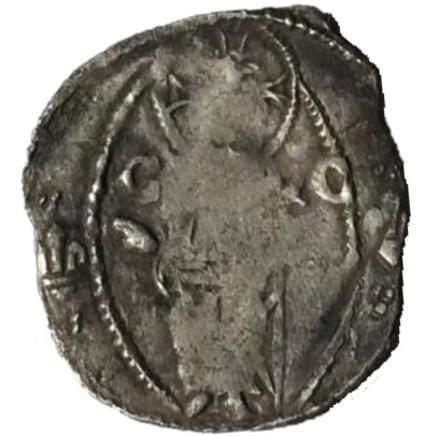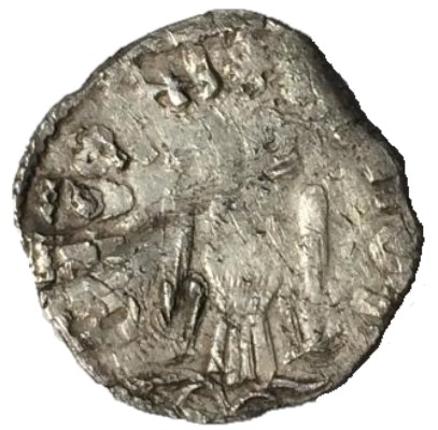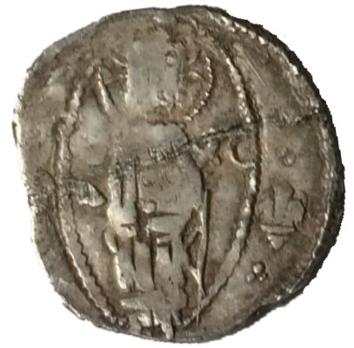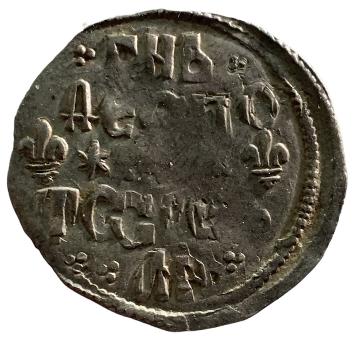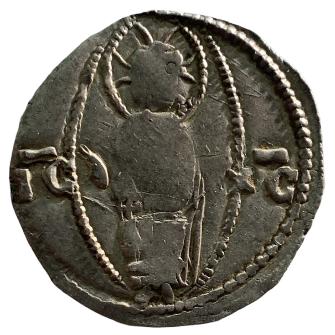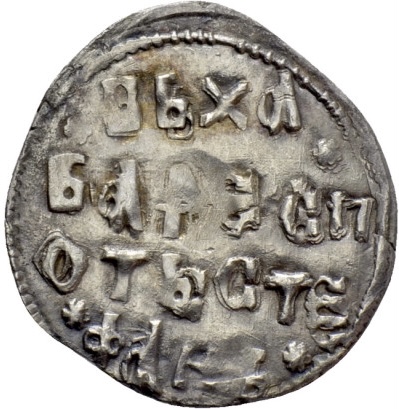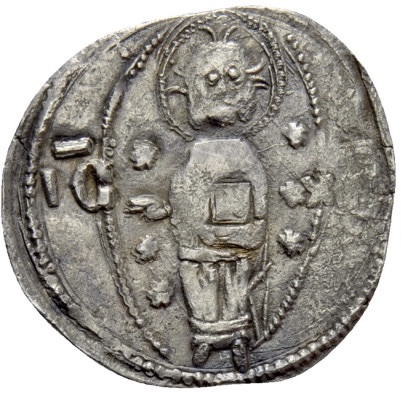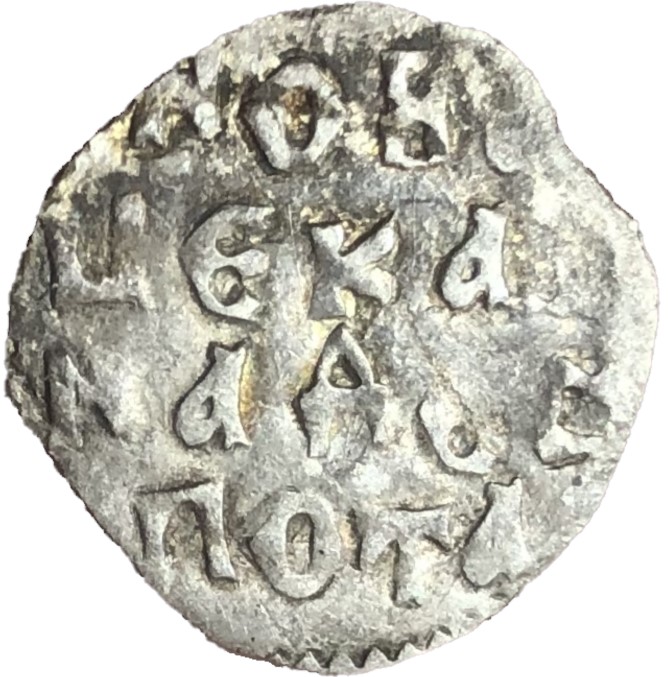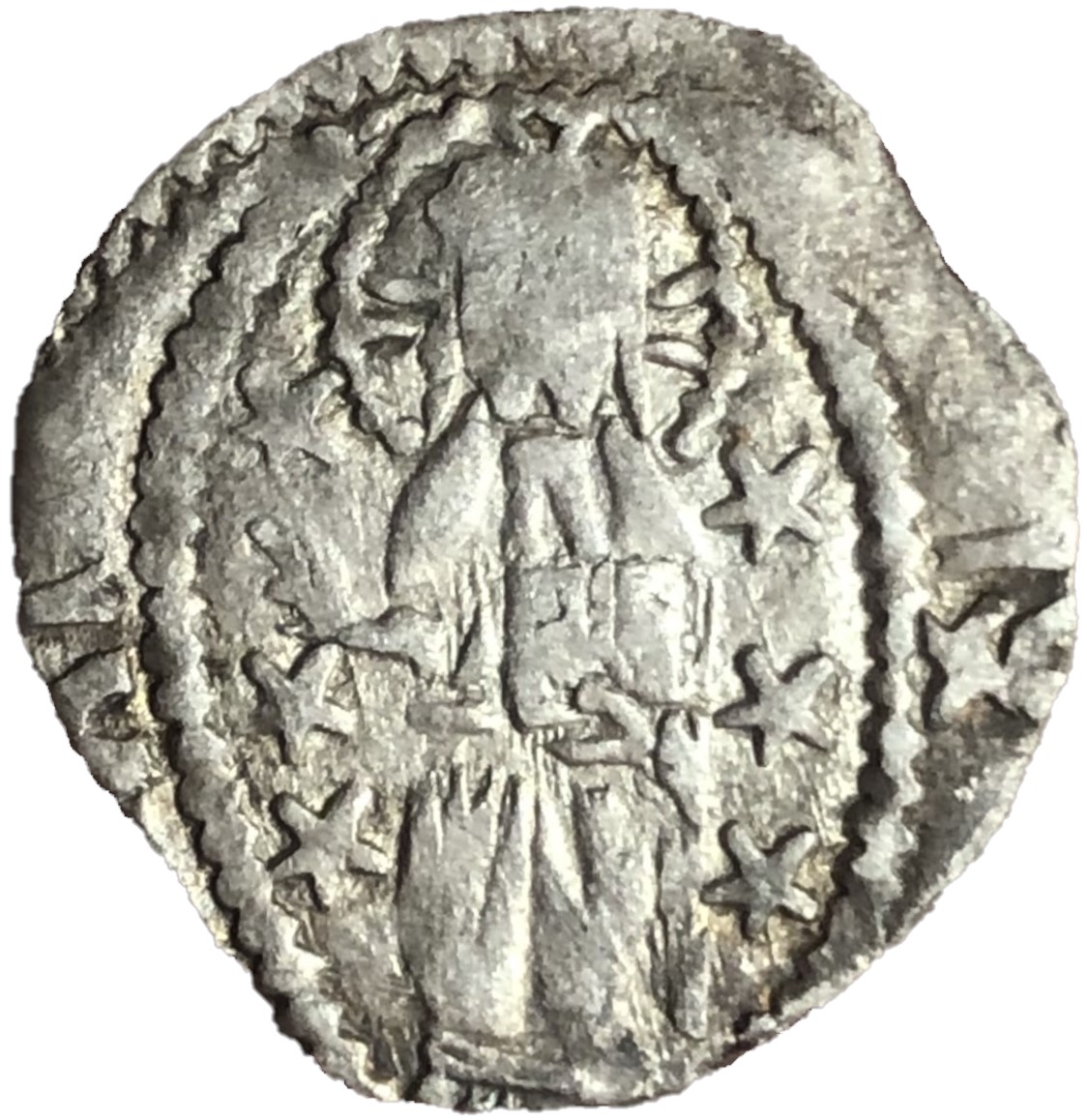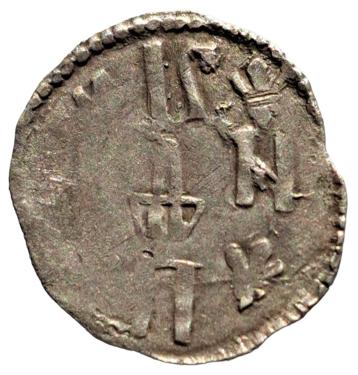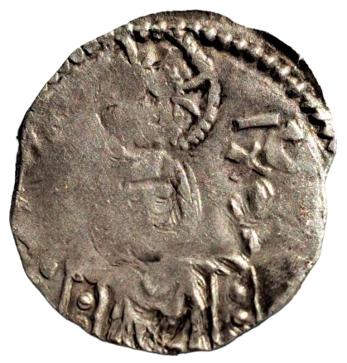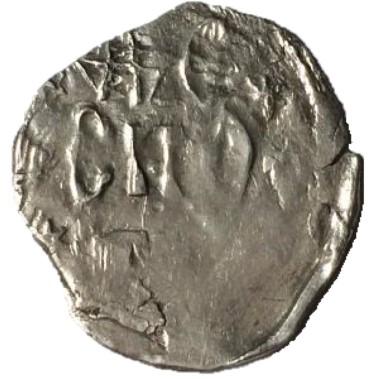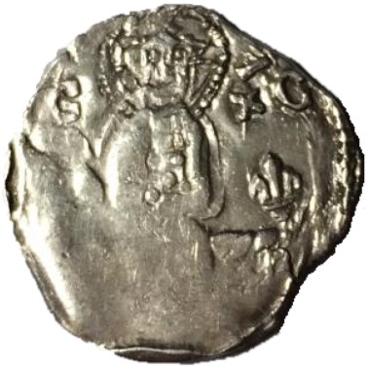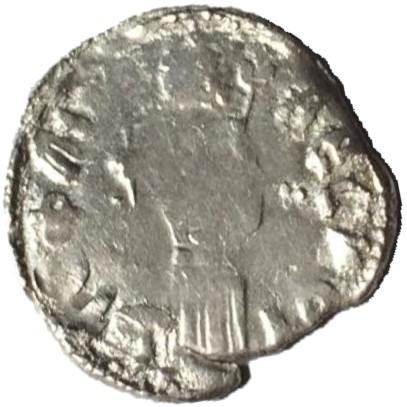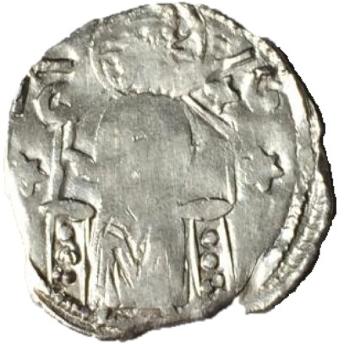Despot Stefan Lazarevic (1402-1427)
Silver "scepter" type. 19mm, 1.291g.
Obverse: Despot standing, facing, fully dressed in royal attire with very prominent curly hair and holding a lily tipped scepter in his right hand. Left hand is on his hip. Serbian initials: • Г • • Д • (SIR DESPOT).
Reverse: Christ seating on the throne decorated with gems, blessing with his right hand and holding scrolls in his left. Greek initials: IC - XC (In Greek: Ιησούς Χριστός - Jesus Christ) above.
Reference: Jov 41 57, J 41 70, I (42.31).
Comment: Very rare scepter type with amazing beautiful patina and extremely well preserved for being more then 600 years old. Lily, a royal symbol of medieval Serbia, is at the top of despots scepter. Very nice early portrait of young despot.
In Jovanovic book are 7 registered examples that have weight of 1.08g, 1.15g, 1.17g, 1.22g, 1.23g, 1.25g and 1.30g so this one with 1.291g is now only 8th registered example.
Despot Stefan Lazarevic was only 12 when his father Knez Lazar died after fighting and defeating invading Ottoman army in the Battle of Kosovo in 1389.
His mother Duchess Milica ruled Serbia until he was old enough to take over. After Ottoman defeat at Ankara (in July 1402) he returned home from the battlefield via Byzantine territory. Following month In August 1402 at Constantinople Byzantine Emperor John VII Palaiologos decided to award him for his efforts the very high title of Despot, second only to Imperial title, it gave him great honour. He proved to be his fathers son following his fathers example in fighting and defeating Ottomans on the battlefield.
On July 19th 1427 he died from a heart attack at the age of just 50.
His royal attire may look little bit like Ottoman attire but I think that is just coincidence as his father fought Ottomans and died fighting them and he fought them all of his life.
Reference: #STL37
Not For Sale
Estimated Value: 2000 - 2500 - 3000
Despot Stefan Lazarevic (1402-1427)
Silver "sword" type. 19mm, 1.158g.
Obverse: Despot seating on the throne decorated with gems, facing, fully dressed in royal attire with very prominent curly hair and holding a sword with both hands. Serbian description: • Г • ДЕ СПОТ (SIR DESPOT).
Reverse: Christ seating on the throne decorated with gems, blessing with his right hand and holding scrolls in his left. Lilies on each side of the throne. Greek reversed initials: CX - CI (In Greek: Ιησούς Χριστός - Jesus Christ) above.
Reference: Jov 41 56, J 41 58, I (42.29).
Comment: Very rare and very well preserved sword type with amazingly beautiful patina. Lily, a royal symbol of medieval Serbia and a Christian symbol is on each side of Jesus throne. This is the only example of Despot Stefan holding sword over his lap like earlier examples of king Stefan Dragutin, king Stefan Uros III Decanski, emperor Stefan Dusan, ban Stefan II and ban Tvrtko I.
Despot Stefan Lazarević was the first member of the Order of the Dragon and one of its founders, the first next to King Sigmund I of Hungary.
The Order of the Dragon, as a royal knightly order, was founded in 1408. on the model of the Crusader knightly orders. The main purpose and idea of this chivalric order was to protect western civilization and Christianity from the encroaching Ottoman danger. The Order of the Dragon was a Christian order that gathered both Orthodox and Catholics alike. After the death of Despot Stefan Lazarevic in 1427 and King Sigmund I in 1437, the importance of the Order in Western Europe unfortunately started to decline. The weakening of the Order of the Dragon played into the hands of the Turks and Europe's failure to unite led to the fall of 3 Christian states, first Constantinople, (Eastern Roman Empire - Byzantium) in 1453, Serbian Despotate in 1459 and medieval Bosnia in 1463. The lesson is clear without unity there is no defense. Only unity saves!
It is interesting that the old Order of the Dragon was restored on June 28, 2011, on Vidovdan, by Prince Aleksandar Karađorđević as a member of the royal family of Serbia. After his death in 2016, the first man of the order is Prince Vladimir Karađorđević. If nothing else the spirit of the Order of the Dragon lives on!
Only 16 registered examples.
Reference: #STL38
Not For Sale
Estimated Value: 1000 - 1500 - 2000
Despot Stefan Lazarevic (1402-1427)
Silver "double cross" dinar.
Obverse: Despot Stefan standing, facing and holding short double cross. Serbian Cyrillic legend: • ДЕСПОТ С ТЕФА • (STEFAN DESPOT) around. 3 dots after name. Sigla Г on the right side.
Reverse: Enthroned Christ in glory (mandorla), facing, blessing with the right hand and holding book of gospels. Greek initials: IC - XC (In Greek: Ιησούς Χριστός - Jesus Christ) above. Single star on the right side.
Reference: J 41-64, Jov 41-64, I 41 21, D 245 1.
Comment: Extremely rare type, in a lovely natural patina. Very hard to find and very interesting type. Sigla Г, and Д on the example below, on obverse next to Despot Stefan, most likely represent an issue number as in serboslavic language Г is number 3 and Д is number 4.
There are only 5 registered examples.
Reference: #STL33
Not For Sale
Estimated Value: 400 - 500 - 600
Detail of Fresco of Despot Stefan Lazarević from Manasija monastery.
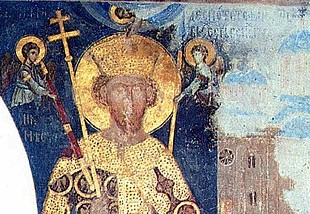
Despot Stefan Lazarevic (1402-1427)
Silver "double cross" dinar. 18mm, 1.2g.
Obverse: Despot Stefan standing, facing and holding short double cross. Serbian Cyrillic legend: • ДЕСПОТ СТЕФ • (STEFAN DESPOT) around. Sigla Д on the right side.
Reverse: Enthroned Christ in glory (mandorla), facing, blessing with the right hand and holding book of gospels. Greek initials: IC - XC (In Greek: Ιησούς Χριστός - Jesus Christ) above. Single star on the right side.
Reference: Unpublished variant compare to J 41-64, Jov 41-65, D 244 1 .
Comment: Extremely rare type, in a lovely natural patina. Image worn but all letters visible. Very hard to find and very interesting type. Sigla Д on the obverse next to Despot Stefan is, on some examples, replaced by a star or letter Г, like axample above.
There are only 4 registered examples as mentioned in Jovanovic catalogue 2012, but all arewith slightly different description: • ДЕСПОТ С ТЕФА •.
One of the main reasons Stefan honored vassal obligations was his sister Olivera that was married to Bayezid in order to keep peace. Olivera was at the same time a kind of hostage. Stephen loved his sister and Bayezid knew this as his weakness. In fact, Stefan's attacks on the Tatars which surrounded the Sultan were desperate attempts to rescue his sister, but with no success. She was later released, through an agreement that was signed between Stefan and Timur. It seems that a ransom wasn't paid, thanks to the great respect that Timur had for Olivera's brother Stefan, and she returned to Serbia (Spring 1403) and a little later she settled permanently in Stefan's castle, in Belgrade. On the other hand, Timur's forces had already left Asia Minor in 1403, and Timur himself died in early 1405, during his expedition to China. In the Ottoman Empire, Bayezid's capture by Timur, and then his death, brought on a civil war between his sons for throne.
Reference: #STL25
Not For Sale
Estimated Value: 400 - 500 - 600
Despot Stefan Lazarevic (1402-1427)
Silver "cross" type. 13mm, 0.421g.
Obverse: Despot Stefan Lazarevic standing holding cross. Serbian Cyrillic legend: + ДЕСП ꙋTb (DESPOT).
Reverse: Christ in glory, standing within the circle of pearls, facing, holding book of gospels. Greek initials: IC - XC (In Greek: Ιησούς Χριστός - Jesus Christ) to the sides.
Reference: Unpublished, unique.
Comment: Extremely rare and up to now completely unknown type. Despot is standing holding cross which is not unusual but the combination of standing ruler and his title alone description with the use of a Greek letter ꙋ (ou) is totally new. There is absence of despots personal name and such title only descriptions with Greek letter have only been found on "horn" types. Please compare with 3 "horn" type examples below. There are types with only the title on coins but without the image of the ruler.
Despot Stefan Lazarevic (1402-1427)
Silver "scepter" coin. 17mm, 1.351g.
Obverse: Despot standing facing, holding the mace in his right hand and a scepter in his left hand. Serbian Cyrillic legend: ДЕСПОТ СТЕФАН (DESPOT STEFAN) around. 2 triple dotted pellets, 1 on each side.
Reverse: Christ enthroned, blessing with his right hand and holding book of gospels in his left hand. Greek initials: IC - XC (In Greek: Ιησούς Χριστός - Jesus Christ) above. 2 stars, 1 on each side.
Reference: J 170, Jov. 41-66, LJ (XII-18), I (42.20), D 239 1,2.
Comment: Rare type where despot is holding a mace a known knight weapon. Being knight of a Dragon Order himself its no surprise that he is portrayed with ox-horned helmet an weapons like sword and the mace.
Reference: #STL40
Not For Sale
Estimated Value: 100 - 150 - 200
Despot Stefan Lazarevic (1402-1427)
Silver "horn" dinar. 16mm, 0.931g.
Obverse: Ox-horned helmet (heraldic symbol of the Hrebeljanovic-Lazarevic dynasty) facing to the left within the circle. Serbian Cyrillic legend: ⛬ ДЕСПОТ СТЕФАНb ⛬ (DESPOT STEFAN) around. 2 triple dotted marks and 1 4 dotted cluster above the helmet. Single star on the right side.
Reverse: Enthroned Christ in glory (mandorla), facing, blessing with the right hand and holding book of gospels. IC XC (Jesus Christ) above. 2 stars, 1 on each side.
Reference: Jov. 49-2, LJ (XIII-30), D 279 45-49.
Comment: Very very rare type in excellent condition, very well preserved and in a lovely natural patina. Plenty of detail with just couple letters missing on the left side on the obverse.
There are only 6 registered examples.
Stefan received the title of despot from the Byzantines in 1402.
Becoming a Hungarian ally in 1403-1404, he received large possessions, including the important Belgrade and Golubac Fortress. He also held the superior rank in the Order of the Dragon. During his reign there was a long conflict with his nephew Đurađ Branković, which ended in 1412. Stefan also inherited Zeta, and waged war against Venice. Since he was childless, he designated his nephew Đurađ as heir in 1426, a year before his death.
Reference: #STL24
Not For Sale
Estimated Value: 400 - 500 - 600
Despot Stefan Lazarevic (1402-1427)
Silver reduced "horn" dinar. 12mm, 0.4g.
Obverse: Ox-horned helmet (heraldic symbol of the Hrebeljanovic-Lazarevic dynasty) and large shield with large one-headed eagle with raised wings on it. Serbian Cyrillic legend: ДЕСПOꙋT (DESPOT).
Reverse: Christ standing within the circle of pearls, facing, holding gospels, IC XC (Jesus Christ).
Reference: Jov. 41-23, LJ (XIII-29), I (42.19), D 280/1 50.
Comment: Very scarce type, associated with the late-19th century Rudnik hoard of Despot Stefan mentioned above.
There are only 31 registered examples.
He came to the throne in a specific time for the state of Lazarević, who found herself surrounded by powerful neighbors. On one side was Bayezid I, who withdrew after the Battle of Kosovo in order to consolidate his power among the Ottomans, while next door there was Vuk Branković, the husband of Stefan's sister Mara, who after the battle became the most powerful of Serbian aristocrats. The neighbor on the west was Bosnian king Tvrtko I (1353–1377 ban, king 1377–1391) which was considered the legitimate successor of Nemanjić crown and he portrayed Battle of Kosovo like his own victory over the Ottomans, while their possessions in the north bordering with Hungary, King Sigismund.
Reference: #STL09
Not For Sale
Estimated Value: 100 - 150 - 200
Stefan Lazarevic Coat of Arms
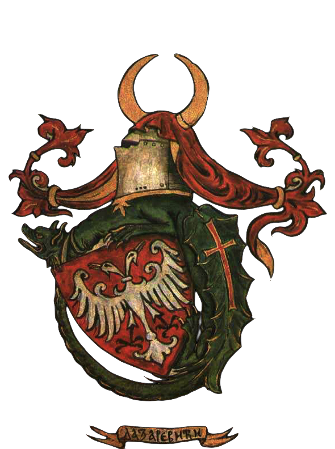
Despot Stefan Lazarevic (1402-1427)
Silver reduced "horn" dinar. 13mm, 0.4g.
Obverse: Ox-horned helmet (heraldic symbol of the Hrebeljanovic-Lazarevic dynasty) and large shield with two-headed eagle with raised wings on it. Serbian Cyrillic legend: ДЕСПOꙋTb (DESPOT).
Reverse: Christ standing within the circle of pearls, facing, holding gospels, IC XC ("Jesus Christ").
Reference: Jov. 41-23, LJ (XIII-29), I (42.19), D 280/1 50.
Comment: Another very scarce type.
On 7th July 1389, three weeks after the battle, Sigismund sent his palatin Nicholas II Garay to negotiate with Vuk Branković about things that are in his and Serbian favor, where he confirmed in advance any agreements that they have achieved. Although both Nicholas and Vuk were married with sisters of Stefan, it was not uncommon at the time that strong neighbors, even relatives, to suppress the legitimate heirs to throne as juvenile. The outcome of these negotiations is not known, but already in the fall, Sigismund began an offensive against young Serbian prince Stefan. His forces have crossed the Sava River in October and early November were they occupied the fortresses of Borač and Čestin, at presents Kragujevac.
Reference: #STL10
Not For Sale
Estimated Value: 100 - 150 - 200
Despot Stefan Lazarevic (1402-1427)
Silver reduced "horn" dinar. 13mm, 0.354g.
Obverse: Ox-horned helmet (heraldic symbol of the Hrebeljanovic-Lazarevic dynasty) and large shield with two-headed eagle with raised wings on it. Serbian Cyrillic legend: +ДЕСПOꙋT (DESPOT).
Reverse: Christ standing within the circle of pearls, facing, holding book of gospels, IC XC ("Jesus Christ") on the sides.
Reference: Jov. 41-23, LJ (XIII-29), I (42.19), D 280/1 50.
Comment: Another very scarce type, like the one above.
Reference: #STL29
Not For Sale
Estimated Value: 100 - 150 - 200
Despot Stefan Lazarevic (1402-1427)
Silver reduced "eagle" dinar. 13mm, 0.3g.
Obverse: Cross in the middle with no pellets in quarters. Serbian Cyrillic legend: ДЕСПОТ СТEФAН (DESPOT STEFAN) around.
Reverse: Double-headed eagle with the wings spread wide and open claws, standing, no legend. 2 dots to the sides.
Reference: Jov. 41-24, I (42.17).
Comment: Very rare type with lovely natural brown patina and toning. In uncleaned condition with clear detail. There were only 6 known examples but the present total is considered to be under 15. Like example below this is early depiction of the Serbian royal symbol, the double-headed eagle.
Reference: #STL27
Not For Sale
Estimated Value: 150 - 200 - 250
Despot Stefan Lazarevic (1402-1427)
Silver reduced "eagle" dinar. 14mm, 0.5g.
Obverse: Cross in the middle with 4 pellets, 1 in each quarter. Serbian Cyrillic legend: +ДЕСПОТ СТФН (DESPOT STEFAN) around.
Reverse: Double-headed eagle with the wings spread wide and open claws, standing, no legend. 4 dots to sides.
Reference: Jov. 41-24, I (42.17).
Comment: Very rare type, from the late-19th century Rudnik hoard of Despot Stefan's, with its 1988 publication there were only 6 known examples; the present total is considered to be under 15. Like above this is a rare and early depiction of the Serbian royal symbol, the double-headed eagle.
Reference: #STL08
Not For Sale
Estimated Value: 150 - 200 - 250
Despot Stefan Lazarevic (1402-1427)
Silver "eagle" dinar. 18mm, 0.8g.
Obverse: Double-headed eagle with wide spread wings and open beak. Serbian legend: ДЕСПОТ СТЕФАН (DESPOT STEFAN) around.
Reverse: Christ standing within the circle of pearls, initials IC XC (Jesus Christ) unusually in the middle next to Jesus, lilies in the field on each side and triple dotted mark on the right side.
Reference: J 186, Jov. 41-57, I (42.35), D 274 44.
Comment: First but different from above examples, depiction of two-headed eagle which is still a symbol of the Serbian State. There are only 20 registered examples.
Other Serbian dynasties also adopted the symbol, like the Mrnjavčević and Lazarević ruling families. Prince Lazar (1371–1389), when renovating the Hilandar monastery of Mount Athos, engraved the double-headed eagle at the northern wall. The Codex Monacensis Slavicus 4 (1371–1389) has richly attested artwork of the Serbian eagle. The double-headed eagle was officially adopted by Stefan Lazarević after he received the despot title, the second highest Byzantine title, by John VII Palaiologos in August 1402 at the court in Constantinople.
Reference: #STL06
Not For Sale
Estimated Value: 200 - 300 - 400
Despot Stefan Lazarevic (1402-1427)
Silver "eagle" dinar. 17mm, 0.8g.
Obverse: Double-headed eagle with wide spread wings and open beak. Serbian legend: ДЕСПОТ СТЕФАН (DESPOT STEFAN) around.
Reverse: Christ standing within the circle of pearls, initials IC XC (Jesus Christ) unusually in the middle next to Jesus, lilies in the field on each side and triple dotted mark on the right side.
Reference: J 186, Jov. 41-57, I (42.35).
Comment: Slightly different variant in shape and size from above.
After the Ottoman invasion and subsequent occupation that lasted until the early 19th century, the double-headed eagle was forbidden to be used as it was a symbol of Serbian sovereignty and statehood. The Serbian cross with four fire-steels ("ocila") came into greater use as another symbol of Serbs as it also was used in the Middle Ages. The emblem has mostly been depicted as a white eagle since 1804, when Stefan Gavrilović, 18th-19th century Serbian painter known best for his iconostasis and frescoes, issued a revolutionary flag based on the Nemanjic eagle for the First Serbian Uprising against the Ottoman Empire.
The eagle, defaced with the cross, has been used in the contemporary design of the coat of arms of Serbia following the tradition established by the Kingdom of Serbia in 1882. The Serbian Revolution resurrected the Nemanjić tradition, and the white double-headed eagle became the symbol of Serbia as the coat of arms following independence from the Ottoman Empire. The Serbian cross has been used as the shield with the Serbian eagle in the contemporary design of the coat of arms of Serbia, following the tradition established by the Kingdom of Serbia of 1882.
Reference: #STL07
Not For Sale
Estimated Value: 200 - 300 - 400
Despot Stefan Lazarevic (1402-1427)
Silver "5 lines" type. 18mm, 1.144g.
Obverse: In 5 lines Serbian description: ∴ ГNb ∴ ДЕСПО ![]() ✶ ✶ ✶
✶ ✶ ✶ ![]() Т ССТЕФ ∴ ∴ АNb ∴ (SIR DESPOT STEFAN).
Т ССТЕФ ∴ ∴ АNb ∴ (SIR DESPOT STEFAN).
Reverse: Christ standing within the circle of pearls and blessing with his right hand. Greek initials: IC - XC (In Greek: Ιησούς Χριστός - Jesus Christ) in the middle.
Reference: Jov 41 33.1, J 41 38, I (42.43), Lj XII-8
Comment: Very rare 5 lines type with amazing patina and 2 lilies, a royal symbol in medieval Serbia, in 3rd line to the sides with 3 stars in the middle between them.
In Jovanovic book from 2012 it is stated that there are 31 registered example with description in 4 lines. However there is only one picture published of type like this in 5 lines with 2 lilies and 3 stars in the middle in 3rd line. Jovanovic doesn’t state how many of these he has seen and registered but it looks like he has put all 4 and 5 line examples together. If we presume that the one pictured on page 205 with 2 lilies and 3 stars in the middle is the only one registered then this one is now only 2nd known example.
There are signs of doubling as there are 2 C letters and 2 triple marks in 4th and 5th line of the coin.
In lines type was first issued by Emperor Dusan in or just after 1346 and continued to be minted by all Serbian medieval kings, princes, despots, nobleman and regional rulers until fall of Serbian Despotate in 1459, for some 113 years.
Reference: #STL41
Not For Sale
Estimated Value: 400 - 500 - 600
Despot Stefan Lazarevic (1402-1427)
Silver "4 lines" type. 19mm, 1.00g.
Obverse: In 4 lines Serbian Cyrillic description: ✶ BБXα ✶ Бα ДЕСП ОТb СТЕ ✶ ФАHb ✶ (IN CHRIST GOD DESPOT STEFAN).
Reverse: Christ standing within the circle of pearls, blessing with his right hand and in his left holding book of gospels decorated with gems. Greek initials: IC - XC (In Greek: Ιησούς Χριστός - Jesus Christ) in the middle. 6 stars within circle, 3 on each side.
Reference: Jov 41 36, J 41 37, I 42.42, Lj XII-7
Comment: Very rare 4 lines type with beautiful patina and 12 stars, 4 on the obverse at the beginning and at the end of first and fourth line and 6 on the reverse within the circle of pearls 3 on the left and 3 on the right, next to Jesus.
While there are many types of Despot Stefan Lazarevic with 2 titles, Sir and Despot, this type omitted Sir title, usually represented with letters ГНb, but adds IN CHRIST GOD and keeps DESPOT title in the description.
Interestingly other similar types from Serbian medieval rulers like emperor Stefan Uros IV Dusan, King Vukasin Mrnjavcevic, Prince Lazar Hrebeljanovic and Zupan Nikola Altomanovic, for example, all had in description expression БЛАГОВЕРНИ (PIOUS) after IN CHRIST GOD. That expression is missing here and it doesn’t appear on any coins of Despot Stefan Lazarevic.
There are 42 registered examples.
Reference: #STL44
Not For Sale
Estimated Value: 400 - 500 - 600
Despot Stefan Lazarevic (1402-1427)
Silver "4 lines" coin. 16mm, 0.6g.
Obverse: Serbian legend in 4 lines: NOBA ЦEKA Г NA ДЕС ПОТA (NEW MONEY SIR DESPOT).
Reverse: Christ standing within the circle of pearls, blessing with his right hand, holding book of gospels, initials IC XC ("Jesus Christ") in the middle. 3 stars on each side.
Reference: Jov 41 38, J 41 41, Lj XII 10, I 42 47, D260 24-26.
Comment: Very rare and interesting type. The reference to "ЦEKA" or "CEKA" is from Italian Zeccha a contemporary Venetian gold coin deriving its name from the Italian for "mint" or "struck coinage" and often known as the "zecchino". The name of the mint ultimately derives from Arabic: (sikka), meaning a coin mold or die.
The design of the Venetian gold ducat or zecchino, remained unchanged for over 500 years, from its introduction in 1284 to the takeover of Venice by Napoleon in 1797. No other coin design has ever been produced over such a long historical period. The reverse bears a motto in Latin hexameter: Sit tibi, Christe, datus / quem tū regis, iste ducātus ("Christ, let this ducat that you rule be given to you"). Initially called "ducat" (ducato), for the ruling Doge of Venice who was prominently depicted on it, it was called the zecchino, after the Zecca (mint) of Venice. The name of the mint ultimately derives from Arabic: (sikka), meaning a coin mold or die.
Following the Venetian model, similar coins were used for centuries throughout the Mediterranean. After two hundred years of continuous zecchino production, the Byzantine Empire imitated with the basilikon. In 1478, the Ottoman Empire introduced a similar unit. In 1535, the Knights Hospitaller of Malta did so. The Ottoman and the Maltese coins were also gold.

Reference: #STL23
Not For Sale
Estimated Value: 200 - 300 - 400
Despot Stefan Lazarevic (1402-1427)
Silver "monogram" type. 18mm, 0.905g.
Obverse: Serbian Cyrillic monogram: IГ ![]() N
N ![]() Д (in the middle) П
Д (in the middle) П ![]() T
T ![]() (SIR DESPOT). 4 lilies around.
(SIR DESPOT). 4 lilies around.
Reverse: Christ sitting on the low back throne, blessing with his right hand and holding book of gospels with his left hand. Greek initials: IC - XC (In Greek: Ιησούς Χριστός - Jesus Christ) with two lilies in the middle.
Reference: Jov 41 44, J 41 45, I 42 54, Lj XIV-16
Comment: Very rare monogram type with nice patina and 6 lilies, a royal symbol in medieval Serbia, 4 on the obverse and 2 on the reverse.
Latin letter I or a upright line may signify the beginning of the monogram description. I is followed by large Serbian Cyrillic Г on the top and N on the right side that is normally found on despot Stefan Lazarevic money in the form ГНb or ГNb, meaning SIR. Despot title begins in the middle with a large Serbian Cyrillic letter Д that is represented with 3 triangles joined together found on some types of the coins of both despot Stefan Lazarevic and later his successor, despot Djuradj Brankovic. Second letter П is on the bottom and letter T is on the left side but not very well visible on this example. Д П Т - ДЕСПОТ (DESPOT).
Monogram type coins must have become popular in the beginning of the 15th century in medieval Serbia as their are not found on earlier rulers coinage. Despot Stefan Lazarevic has most monogram types of all Serbian medieval rulers especially ones with just titles like SIR and DESPOT. I have counted 17 different monogram title only types but it could be more.
This type has only 11 registered examples.
Reference: #STL43
Not For Sale
Estimated Value: 400 - 500 - 600
Despot Stefan Lazarevic (1402-1427)
Silver "3 lines" coin. 16mm, 0.844g.
Obverse: Serbian Cyrillic legend in 2 lines and 4 parts, divided with the cross: Д Е СП ОТ (DESPOT).
Reverse: Christ standing within the circle of pearls, facing and holding book of gospels decorated with 5 gems, initials IC XC (In Greek: Ιησούς Χριστός - Jesus Christ) to the sides.
Reference: Jov 41 40, J 41 44, LJ XII-13, I 42.46.
Comment: Another letters only example but different from 2 examples below. Same decorative letter Д (D) like example below, #STL16. This example is slightly different from one published in Jovanovic book, IC XC here are in a lower position more in the middle where in Jovanovic catalogue initials are high up next to Jesus head.
Only 10 registered examples.
Reference: #STL30
Not For Sale
Estimated Value: 400 - 500 - 600
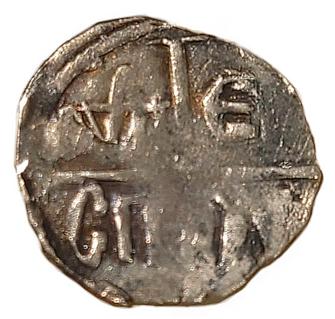
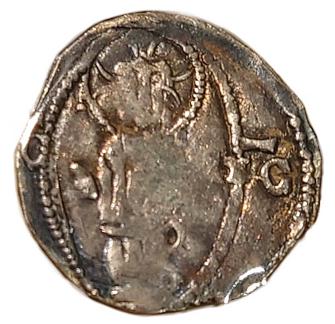
Despot Stefan Lazarevic (1402-1427)
Silver "3 lines" coin. 17mm, 1g.
Obverse: Serbian Cyrillic legend in 3 lines: ДЕ СПО Тb (DESPOT). 4 stars and 2 lilies around.
Reverse: Christ sitting on the low-back throne, holding book of gospels decorated with 5 gems, initials IC XC ("Jesus Christ") above, lilies to the sides.
Reference: Jov 41 41, J 41 42, LJ XII-20, I 42.49.
Comment: Another letters only example.
Stefan was receptive when Sigismund of Hungary approached him for an alliance. Despot Stefan received Mačva, Belgrade (which became Lazarević's capital in 1405), Golubac (an important fortress on the Danube) and other domains, such as lands in Vojvodina (Zemun, Slankamen, Kupinik, Mitrovica, Bečejand Veliki Bečkerek) in 1404, Apatin in 1417 and Srebrenica in 1411. At Belgrade, he built a fortress with a citadel (which was destroyed during the Great Turkish War in 1690; only the Despot Stefan Tower remains today).
42 registered examples.
Reference: #STL16
Not For Sale
Estimated Value: 200 - 300 - 400
Despot Stefan Lazarevic (1402-1427)
Silver "3 lines" coin. 16mm, 0.791g.
Obverse: Serbian Cyrillic 2 letter monogram: П Т (DESPOT). 4 lilies around.
Reverse: Christ standing within the circle of pearls, facing and holding book of gospels decorated with 5 gems, initials IC XC (In Greek: Ιησούς Χριστός - Jesus Christ) and 2 lilies to the sides.
Reference: Jov 41 45, J 41 48, LJ XII-15, I 42.51.
Comment: Extremely rare letters only example. Cracked but not broken.
Very interesting and rare presentation of the title Despot using just 2 letters.
Only 3 registered examples.
Reference: #STL31
Not For Sale
Estimated Value: 400 - 500 - 600
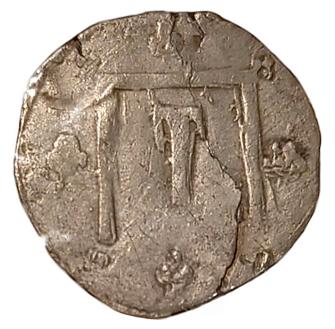
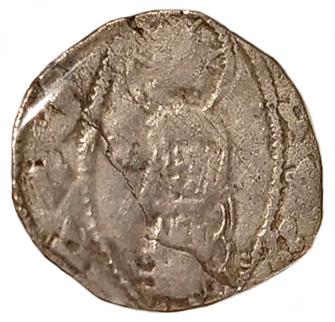
Despot Stefan Lazarevic (1402-1427)
Silver "sword" dinar, 1.1g
Obverse: Despot standing, facing, holding sword with his right hand. Serbian legend: ГНДЕСП СТЕФ (SIR DESPOT STEFAN).
Reverse: Christ in glory, seating on the throne, initials IC XC ("Jesus Christ").
Reference: Jov. 41-67, Lj (XII-19), I (42.22).
Comment: Very rare sword type. Was only 12 when his father died in the Battle of Kosovo in 1389. His mother Duchess Milica ruled until he was old enough to take over at the age of 25. On July 19th 1427 he died from a heart attack at the age of 50.
Order info: #STL01. (SOLD)
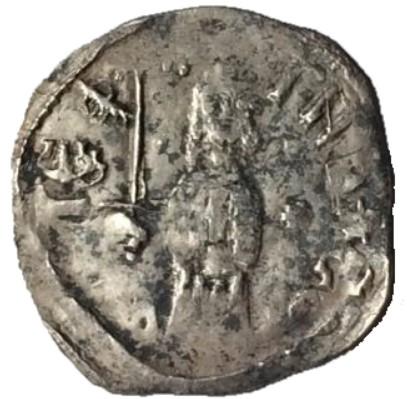
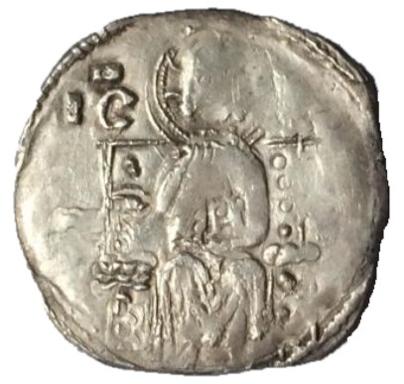
Despot Stefan Lazarevic (1402-1427)
Silver "scepter" coin. 18mm, 1.3g.
Obverse: Prince standing facing, holding labarum, Serbian Cyrillic legend ДЕСПОТ СТЕФАН (DESPOT STEFAN)
Reverse: Christ enthroned with Book of Gospels, IC - XC (Jesus Christ) and stars to the sides.
Reference: J 170, Jov. 41-66, LJ (XII-18), I (42.20), D 239 1,2.
Comment: Another rare heavier coin, possibly earlier type.
Reference: #STL13
Not For Sale
Estimated Value: 100 - 150 - 200
Despot Stefan Lazarevic (1402-1427)
Silver "scepter" coin. 1g.
Obverse: Prince standing facing, holding labarum. Serbian Cyrillic legend: СТЕФАН ДЕСПОТ (STEFAN DESPOT) .
Reverse: Christ enthroned with book of gospels, IC - XC ("Jesus Christ") above and stars to the sides.
Reference: J 170, Jov. 41-66, LJ (XII-18), I (42.20).
Comment: Another rare heavier coin, possibly earlier type.
Order info: #STL14. (SOLD)
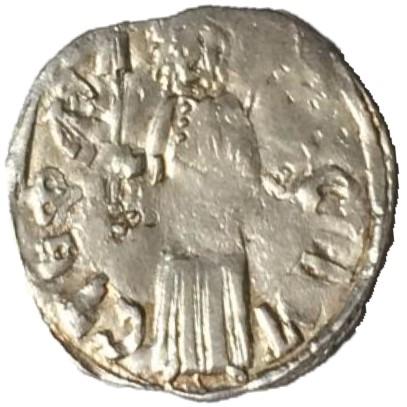
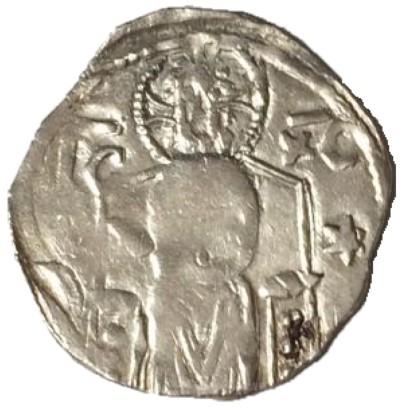
Despot Stefan Lazarevic (1402-1427)
silver "4 lines" coin. 0.9g.
Obverse: Serbian legend in 4 lines: + ГНb ДЕСПОТ СТЕФАNb (SIR DESPOT STEFAN)
Reverse: Christ standing within the circle of pearls, holding book of gospels, initials IC XC ("Jesus Christ") in the middle.
Reference: J 166, Jov. 41-38, LJ (XII-8), I (42.43).
Comment: As the coins over time went lighter and lighter in weight this example could be an earlier issue.
Order info: #STL15. (SOLD)
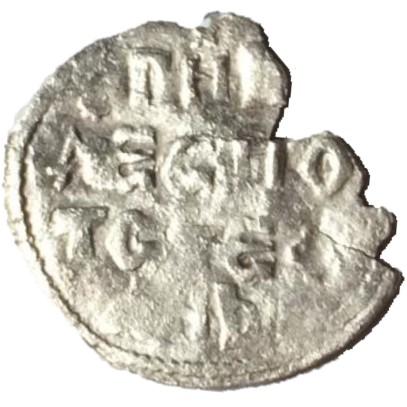
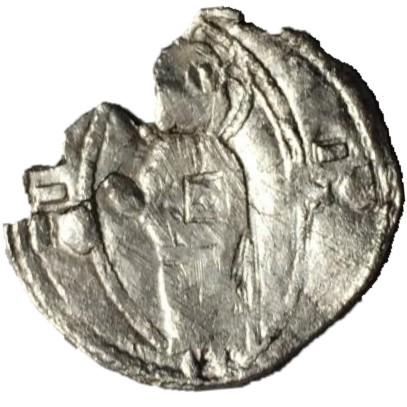
Copyright © 2020
